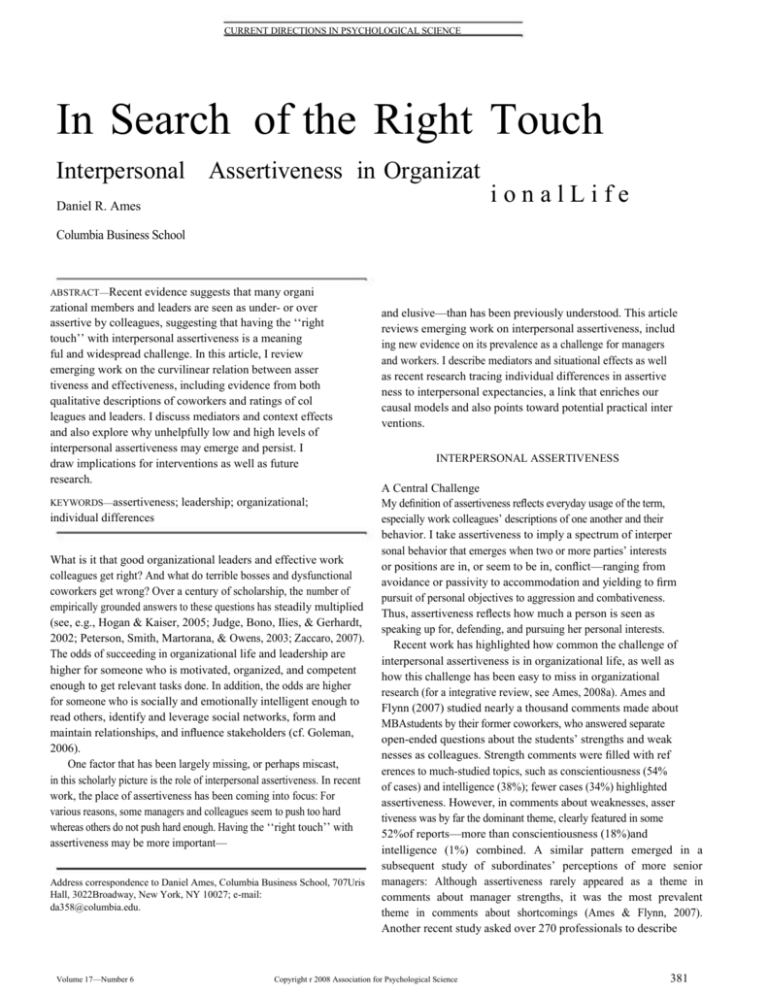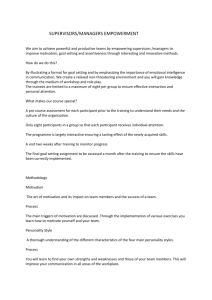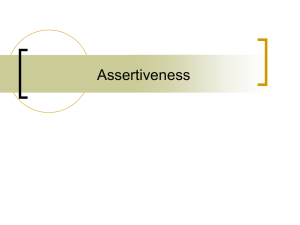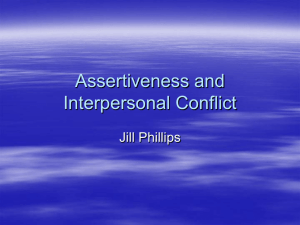CURRENT DIRECTIONS IN PSYCHOLOGICAL SCIENCE In Search
advertisement

CURRENT DIRECTIONS IN PSYCHOLOGICAL SCIENCE In Search of the Right Touch Interpersonal Assertiveness in Organizat ionalLife Daniel R. Ames Columbia Business School ABSTRACT—Recent evidence suggests that many organi zational members and leaders are seen as under- or over assertive by colleagues, suggesting that having the ‘‘right touch’’ with interpersonal assertiveness is a meaning ful and widespread challenge. In this article, I review emerging work on the curvilinear relation between asser tiveness and effectiveness, including evidence from both qualitative descriptions of coworkers and ratings of col leagues and leaders. I discuss mediators and context effects and also explore why unhelpfully low and high levels of interpersonal assertiveness may emerge and persist. I draw implications for interventions as well as future research. KEYWORDS—assertiveness; leadership; organizational; individual differences What is it that good organizational leaders and effective work colleagues get right? And what do terrible bosses and dysfunctional coworkers get wrong? Over a century of scholarship, the number of empirically grounded answers to these questions has steadily multiplied (see, e.g., Hogan & Kaiser, 2005; Judge, Bono, Ilies, & Gerhardt, 2002; Peterson, Smith, Martorana, & Owens, 2003; Zaccaro, 2007). The odds of succeeding in organizational life and leadership are higher for someone who is motivated, organized, and competent enough to get relevant tasks done. In addition, the odds are higher for someone who is socially and emotionally intelligent enough to read others, identify and leverage social networks, form and maintain relationships, and influence stakeholders (cf. Goleman, 2006). One factor that has been largely missing, or perhaps miscast, in this scholarly picture is the role of interpersonal assertiveness. In recent work, the place of assertiveness has been coming into focus: For various reasons, some managers and colleagues seem to push too hard whereas others do not push hard enough. Having the ‘‘right touch’’ with assertiveness may be more important— Address correspondence to Daniel Ames, Columbia Business School, 707Uris Hall, 3022Broadway, New York, NY 10027; e-mail: da358@columbia.edu. Volume 17—Number 6 and elusive—than has been previously understood. This article reviews emerging work on interpersonal assertiveness, includ ing new evidence on its prevalence as a challenge for managers and workers. I describe mediators and situational effects as well as recent research tracing individual differences in assertive ness to interpersonal expectancies, a link that enriches our causal models and also points toward potential practical inter ventions. INTERPERSONAL ASSERTIVENESS A Central Challenge My definition of assertiveness reflects everyday usage of the term, especially work colleagues’ descriptions of one another and their behavior. I take assertiveness to imply a spectrum of interper sonal behavior that emerges when two or more parties’ interests or positions are in, or seem to be in, conflict—ranging from avoidance or passivity to accommodation and yielding to firm pursuit of personal objectives to aggression and combativeness. Thus, assertiveness reflects how much a person is seen as speaking up for, defending, and pursuing her personal interests. Recent work has highlighted how common the challenge of interpersonal assertiveness is in organizational life, as well as how this challenge has been easy to miss in organizational research (for a integrative review, see Ames, 2008a). Ames and Flynn (2007) studied nearly a thousand comments made about MBAstudents by their former coworkers, who answered separate open-ended questions about the students’ strengths and weak nesses as colleagues. Strength comments were filled with ref erences to much-studied topics, such as conscientiousness (54% of cases) and intelligence (38%); fewer cases (34%) highlighted assertiveness. However, in comments about weaknesses, asser tiveness was by far the dominant theme, clearly featured in some 52%of reports—more than conscientiousness (18%)and intelligence (1%) combined. A similar pattern emerged in a subsequent study of subordinates’ perceptions of more senior managers: Although assertiveness rarely appeared as a theme in comments about manager strengths, it was the most prevalent theme in comments about shortcomings (Ames & Flynn, 2007). Another recent study asked over 270 professionals to describe Copyright r 2008 Association for Psychological Science 381 Interpersonal Assertiveness the worst and best leaders for whom they had ever worked (Ames, 2007).Parallel to the results based on weakness comments, assertiveness was a clear theme in nearly half the descriptions of worst leaders (more prevalent than other dimensions, including supportiveness, communication, and integrity), though it ap peared in only a quarter of best-leader descriptions (far less often than supportiveness, communication, and integrity). Had these studies focused on the strengths of colleagues and descriptions of great leaders, assertiveness would have been easy to dismiss. One reason for this asymmetry—with asser tiveness a major theme in ineffective but not effective manage ment—may be the fact that, unlike many other leadership qualities, assertiveness was seen as a shortcoming in both di rections: too much and too little. Indeed, in the first study noted above, comments about assertiveness as a weakness were split almost equally between overassertiveness (48%)and underassertiveness (52%). Moderate assertiveness may be like a causal background condition or a necessary but insufficient cause: When in place, it is unremarkable, and onlookers’ at tention is drawn to other vivid and seemingly sufficient factors, including linear predictors of effectiveness such as conscien tiousness. However, when assertiveness registers as too low or high, it may dominate attention, eclipsing other qualities and interrupting effectiveness. A Curvilinear Link with Multiple Mediators These results suggest that assertiveness has an inverted-Ushaped relationship with effectiveness. Research using continuous measures of assertiveness and outcomes yields results consistent with this (Ames, 2007). In a study contrasting reports on the worst and best leaders with whom informants had worked, the distribution of assertiveness differed markedly: Few best leaders appear to possess extreme levels of assertiveness, Distribution of Assertiveness Among Worst and Best Leaders whereas worst leaders were more common at both the low and high ends of the assertiveness spectrum (see Fig. 1). Other ev idence comes from reports across a wide range of managers, attempting to predict their effectiveness. Here, ratings of assertiveness have shown a curvilinear relation with various dependent measures, including leadership effectiveness and expected future success (e.g., Ames & Flynn, 2007). Both leaders comparatively low in assertiveness and those compara tively high in assertiveness were rated worse than those in the middle range (Fig. 1). How are low and high levels of assertiveness harmful? The impact of assertiveness can be decomposed into two domains: instrumental and relational outcomes. Prior work suggests that increasing interpersonal assertiveness has a positive effect on instrumental outcomes (e.g., completing tasks, securing resources) but a negative effect on social outcomes (e.g., culti vating rapport, sustaining trust). This pair of effects may imply that, as assertiveness increases, gains in the instrumental domain could offset losses in the social domain, and overall effectiveness would somehow remain constant rather than show a curvilinear effect. However, work on negativity effects (e.g., Baumeister, Bratslavsky, Finkenauer, & Vohs, 2001) suggests that onlookers weigh losses more heavily than gains. At low levels of assertiveness, coworkers may focus on a colleague’s ‘‘instrumental impotence’’ more than on her social achieve ments. At high levels of assertiveness, coworkers may attend more to a colleague’s ‘‘social insufferability’’ than to her in strumental success. This prediction was borne out in a study of subordinate ratings of leaders (Ames & Flynn, 2007). Mediation analyses showed that, at low levels of assertiveness, instru mental outcomes (‘‘able to get his/her way and accomplish work goals’’) but not social ones (‘‘able to build positive relationships and trust’’) accounted for the link between assertiveness and effectiveness. At high levels of assertiveness, social outcomes Assertiveness Predicting Effectiveness Worst leaders Best leaders Interpersonal Assertiveness Interpersonal Assertiveness Fig. 1. Distribution of assertiveness among leaders rated worst and best by coworkers (left graph; based on Ames, 2007) and assertiveness as a predictor of effectiveness (right graph; based on Ames & Flynn, 2007). Ineffective leaders are more likely to display extreme low or high levels of assertiveness; moderate interpersonal assertiveness is associated with higher levels of effectiveness and more effective leadership. 382 Volume 17—Number 6 Daniel R. Ames but not instrumental ones accounted for the link. Thus highly assertive leaders tended to be ineffective largely because they failed to get along, whereas relatively unassertive leaders tended to be ineffective largely because they failed to get things done. Situationally Appropriate Assertiveness The level of assertiveness that is adaptive in one situation may not be effective in the next. Norms for assertiveness certainly vary by culture, organization, relationship, task, and other contexts. Recent work has taken up this issue, exploring whether situational appropriateness matters and whether a manager’s ‘‘average assertiveness’’ is even a meaningful concept (Ames, 2008b). Two studies used professionals’ reports on their man agers across situations, including the manager’s behavior with subordinates, superiors, customers, and suppliers (of course, this is not the only way to operationalize situations, but it cap tures different task and status dynamics; respondents indicated that these domains were meaningful in their perceptions of manager assertiveness). The responses showed that situationally appropriate assertiveness—for instance, showing what infor mants saw as an appropriate level of assertiveness with cus tomers—predicted perceived manager effectiveness beyond the impact of average assertiveness. Thus, it is not simply that effective managers chronically display moderate assertiveness, but rather that they tend to fit their behavior to the situation’s demands, an effect that is consistent with a long tradition of work on situational and contingent leadership approaches (e.g., Fie dler & Chemers, 1974) and with work on behavioral flexibility and self-monitoring (e.g., Day & Schleicher, 2006; Zaccaro, Foti, & Kenny, 1991). While these context effects were noteworthy, cross-situational consistency in behavior was also apparent. The levels of assertiveness managers displayed toward subordinates, superiors, customers, and suppliers were positively correlated. Indeed, a manager’s assertiveness in any given context (e.g., toward subordinates) was substantially better predicted by the manager’s apparent assertiveness in other contexts (e.g., toward superiors, customers, and suppliers) than it was by what informants saw as the appropriate level of assertiveness for the given context. Moreover, under- and overassertiveness appeared to carry across domains. On average, under- and overassertiveness in one domain (e.g., with subordinates) made managers three to four times more likely to be seen as similarly miscalibrated (under- or overassertive) in other domains compared to those who were not miscalibrated in that way. Thus, although the most effective managers may be capable of calibrating their assertiveness across situations, emerging evidence suggests that such calibration may be a challenge many managers meet only in part. Sources of Interpersonal Assertiveness If calibrated assertiveness is so important, what explains people’s tendency to display unhelpfully low and high levels of Volume 17—Number 6 interpersonal assertiveness? One possibility is that people rec ognize that their assertiveness is dysfunctionally extreme but do not know how to change or do not believe that they can change. Such may be the case for some extremely shy individ uals, for instance, who see their behavior as unwanted but unmalleable. Others may recognize the social or instrumental costliness of their assertiveness, and yet proceed contentedly because their behavior faithfully reflects their motives. In other words, they have little interest in changing. This appears to be the predominant answer offered in the conflict, social dilemma, and negotiations literatures (e.g., Carnevale & De Dreu, 2006). Highly assertive people push hard, this logic goes, because they habitually want to win and they care less about others; unas sertive people yield because they typically just want to get along. There is no question that these motivations vary from person to person and that this explains some share of variance in indi vidual assertiveness. However, another mechanism may be at work as well. My firsthand experience in coaching professionals either low or high in assertiveness who receive feedback from coworkers is that many of them are partly or profoundly unaware of how their behavior is perceived by others. This is echoed in research that suggests that as many as half of underassertive or overassertive managers are seen by their own subordinates as generally unaware that their level of assertiveness is inappro priate (Ames, 2008b). Such limited self-awareness is reflected in other work on multirater feedback (e.g., London & Wohlers, 1991)and self-perception more generally (e.g., Dunning, 2005). One mechanism that fits with this lack of self-awareness is interpersonal expectancies (e.g., Baldwin, 2005). People make idiosyncratic predictions about how others will react to a given level of assertiveness. One person might think, for example, that if she politely but firmly refused a colleague’s request for re sources, the colleague would regard her with disdain. Another person might consider the same refusal, predicting that the colleague would find it acceptable or even admirable. Even if these two people had exactly the same motive to protect the relationship, they might differ in their behavior (e.g., declining the request vs. granting it) simply because they anticipate different outcomes. Because feedback on whether such expec tancies are correct may be rare, people may persist in habitually low-assertive or high-assertive behavior, believing it to be rea sonable and adaptive, without knowing that others see their style as too weak or too harsh. Recent work (Ames, in press) suggests that ‘‘assertiveness expectancies’’ play a meaningful role in explaining individual levels of assertiveness. In a series of studies, participants read about workplace scenarios such as a salary negotiation and expressed their expectancies by noting the social and instrumental outcomes that they expected would follow from different behaviors ranging from low assertiveness to high assertiveness. These expectancy ratings predicted how other people rated the participants’ actual assertiveness in other contexts at different 383 Interpersonal Assertiveness times. Those who expected relatively minimal costs from high levels of interpersonal assertiveness (e.g., expecting a manager would find an aggressive counteroffer in a salary negotiation acceptable) were seen by subsequent negotiation partners and work colleagues as considerably more assertive than those who forecast that those same behaviors would entail great costs (e.g., expecting that the manager would find a counteroffer offensive). The effects of these expectancies were distinct from effects of social motives, suggesting that complete models of assertive behavior should incorporate both motivations and expectancies. There are, then, a number of reasons why unadaptively low or high levels of interpersonal assertiveness might persist. Some people believe they cannot change or do not know how to change. Others recognize the impact they have and are content that these outcomes match their objectives. Still others are unaware of how their behavior is seen by colleagues, with their assertiveness reflecting overly pessimistic or optimistic expectancies about the impact of pushing back. FUTURE DIRECTIONS Emerging evidence suggests that having the ‘‘right touch’’ with interpersonal assertiveness is an important factor in organiza tional and leadership effectiveness. For many managers, this balancing act—pushing hard enough to be instrumentally effective but not so hard as to undermine relationships—is a difficult one. The results noted here suggest that when individ uals strike the wrong balance, they are likely to do so across contexts and may often be unaware that their behavior is seen as wide of the mark. This emerging body of work has a number of practical impli cations. One is that multirater feedback systems in organizations should gauge interpersonal assertiveness. If many managers do not realize how others see their assertiveness, coworker feed back could reveal a need to push harder or ease up. Another implication is that clinicians and coaches who work with indi viduals exhibiting unhelpfully low or high levels of assertiveness might consider altering expectancies as an approach to altering behavior. It may be possible to calibrate assertiveness by en couraging individuals to test and revise their expectancies (‘‘outcome expectations’’ in Bandura’s [1977] terms). Individuals chronically low in assertiveness may overturn their pessimism about what moderate assertiveness might achieve; individuals chronically high in assertiveness may curb their optimism about the consequences of aggression. Moreover, calibrating expec tancies for particular situations and contexts could lead to more situationally appropriate assertiveness. There is much left to discover about assertiveness. One promising research direction concerns the limits and boundaries of the effects described here. Recent results suggest that while appropriate assertiveness is linked to effectiveness for both male and female managers, female managers may be more harshly judged for overassertiveness whereas male managers may be 384 more harshly judged for underassertiveness (Ames, 2008b). Future research might explore how gender, perceiver stereotypes, organizational context, and other factors affect the perception of interpersonal assertiveness. The results reviewed here also have a broader implication for scholars of interpersonal relations and organizational behavior: Commonly used research methods and vantage points may bring some effects, such as linear predictors, into focus while leaving others, such as curvilinear dynamics, unnoticed or obscured (cf. Simonton, 1995; Zaccaro, 2007). Researchers may understand interpersonal dynamics and organizational life more fully by observing when and why both ‘‘not enough’’ and ‘‘too much’’ of a good thing can bring misfortune. Recommended Reading Ames, D.R. (in press). (See References). Examines the form asser tiveness expectancies take as well as their ability to predict assertive behavior. Ames, D.R., & Flynn, F.J. (2007). (See References). Documents the prevalence of assertiveness as a challenge for managers, as well as the curvilinear link between assertiveness and effectiveness. Baldwin, M.W (Ed.). (2005). (See References). An edited volume sur veying contemporary perspectives on relational cognition, in cluding expectancies and relationship models. Judge, T.A., Bono, J.E., Ilies, R., & Gerhardt, M.W (2002). (See Ref erences). Presents a qualitative review of the trait perspective in leadership research and a meta-analysis of links between the Big Five traits and leadership. Zaccaro, S.J. (2007). (See References). A brief review of the history of trait accounts of leadership, as well as an integrated model that distinguishes between distal and proximal attributes and specifies a role for situations. REFERENCES Ames, D.R. (2007).More than one way to fail as a leader: How the worst bosses get assertiveness wrong. Unpublished manu script. Ames, D.R. (2008a). Pushing up to a point: Assertiveness and effective ness in interpersonal dynamics and organizational life. Manuscript submitted for publication. Ames, D.R. (2008b). Managers’ interpersonal assertiveness across situ ations: Does fit matter? Is behavior consistent? Manuscript sub mitted for publication. Ames, D.R. (in press). Assertiveness expectancies: How hard people push depends on the consequences they predict. Journal of Per sonality and Social Psychology. Ames, D.R., & Flynn, F.J. (2007). What breaks a leader: The curvilinear relation between assertiveness and leadership. Journal of Personality and Social Psychology, 92, 307-324. Baldwin, M.W (Ed.). (2005).Interpersonal cognition. New York: Guilford. Bandura, A. (1977). Self-efficacy: Toward a unifying theory of behav ioral change. Psychological Review, 84, 191-215. Volume 17—Number 6 Daniel R. Ames Baumeister, R., Bratslavsky, E., Finkenauer, C., & Vohs, K. (2001). Bad is stronger than good. Review of General Psychology, 5, 323 370. Beer, J.S. (2002). Implicit self-theories and shyness. Journal of Per sonality and Social Psychology, 83, 1009-1024. Carnevale, P.J., & De Dreu, C.K.W (2006). Motive: The negotiator’s raison d’eˆtre. In Leigh Thompson (Ed.), Frontiers of social psy chology: Negotiation theory and research (pp. 55-76). New York: Psychology Press. Day, D.V , & Schleicher, D.J. (2006).Self-monitoring at work: A motive-based perspective. Journal of Personality, 74, 685 713. Dunning, D. (2005). Self-insight: Roadblocks and detours on the path to knowing thyself. New York: Psychology Press. Fiedler, F.E., & Chemers, M.M. (1974).Leadership and effective management. Glenview, IL: Scott, Foresman. Goleman, D. (2006). Social intelligence: The new science of human relationships. New York: Bantam Books. Hogan, R., & Kaiser, R.B. (2005). What we know about leadership. Review of General Psychology, 9, 169-180. Volume 17—Number 6 Judge, T.A., Bono, J.E., Ilies, R., & Gerhardt, M.W (2002). Personality and leadership: A qualitative and quantitative review. Journal of Applied Psychology, 87, 765-780. London, M., & Wohlers, A.J. (1991). Agreement between subordinate and self-ratings in upward feedback. Personnel Psychology, 44, 375-390. Peterson, R.S., Smith, D.B., Martorana, PV , & Owens, PD. (2003). The impact of chief executive officer personality on top management team dynamics: One mechanism by which leadership affects organiza tional performance. Journal of Applied Psychology, 88, 795-808. Simonton, D.K. (1995). Personality and intellectual predictors of leadership. In D.H. Saklofske & M. Zeidner (Eds.), International handbook of personality and intelligence (pp. 739-757). New York: Plenum. Zaccaro, S.J. (2007). Trait-based perspectives of leadership. American Psychologist, 62, 6-16. Zaccaro, S.J., Foti, R.J., & Kenny, D.A. (1991). Self-monitoring and trait-based variance in leadership: An investigation of leader flexibility across multiple group situations. Journal of Applied Psychology, 76, 308-315. 385







